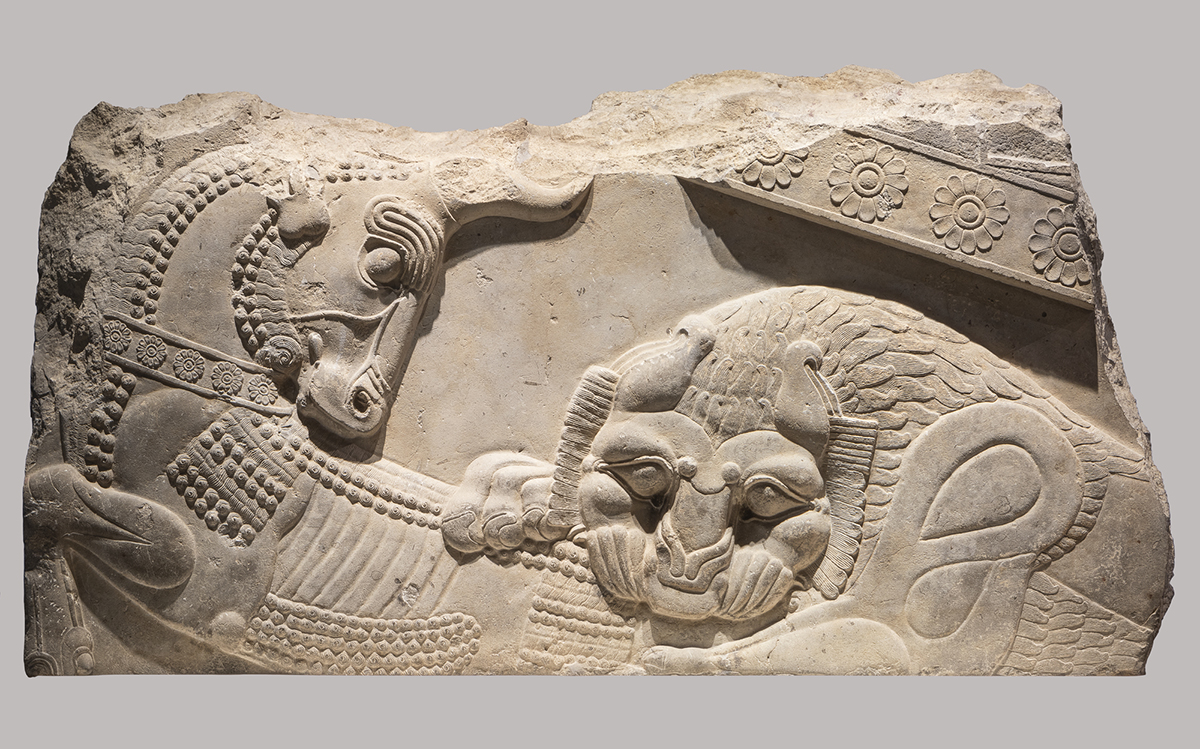Getty Villa exhibition explores Persia’s cultural power in ancient world

Made of limestone, the “Relief with a Lion and Bull in Combat” is on display at the Getty Villa as part of the exhibition “Persia: Ancient Iran and the Classical World.” (Courtesy of the Oriental Institute of the University of Chicago, Photo: Michael Tropea)
"Persia: Ancient Iran and the Classical World”
The Getty Villa
April 6 to Aug. 8
By Paria Honardoust
April 19, 2022 5:43 p.m.
This post was updated April 20 at 12:00 p.m.
Ancient Persia is expanding its influence once more – this time, at the Getty Villa.
The art museum is featuring the exhibition “Persia: Ancient Iran and the Classical World” until Aug. 8. Created with a cultural partner, the Farhang Foundation, and an academic partner, UCLA’s Pourdavoud Center for the Study of the Iranian World, the exhibition examines the connections between ancient Persia and its rival powers of Greece and Rome. Displaying artifacts sourced from various museums including the British Museum and the Louvre Museum, “Persia: Ancient Iran and the Classical World” focuses on cultural and artistic connections between these ruling powers, said Jeffrey Spier, senior curator of antiques.
“The Getty Villa has mostly Greek, Roman and Etruscan classical art, but we feel we really need to involve the other cultures that Greece and Rome interacted with because the ancient world is a very interconnected place,” Spier said. “The first one (exhibition) a few years ago was Egypt. … Persia is the other great culture.”
Historically, Persia and its three ruling dynasties maintained dominance over western Asia from 550 B.C. to 650 A.D., becoming the largest under the Achaemenid Empire and Cyrus the Great. The exhibition is split into three distinct galleries representing the different ruling eras – the Achaemenid, Parthian and Sasanian empires – all evoking their period’s unique character within their designated galleries, Spier said. In an effort to embody the historical themes of royalty and power, the Getty Villa incorporated cultural objects that exemplify Persia’s contemporary influence, including luxury silver and gold vessels and golden swords that were royal gifts of status as well as stone reliefs from the palace of Persepolis, he said.
[Related: Hammer Museum’s new exhibitions connect past, present with different art forms]
The exhibition includes an immersive digital experience of the palace of Persepolis where visitors can revert back in time and walk through the capital’s palace in its original, sustained form, further complementing the decorative artifacts, said Alireza Ardekani, collaborator and executive director of the Farhang Foundation. To preserve the authenticity of the ancient construction, many scholars and hours were involved in trying to achieve architectural accuracy through historical referencing, Ardekani said.
UCLA also contributed to the Persia experience with the implementation of music. The Getty Villa has a music program called “After Hours,” which supplements the viewing experience with live musical sets, said Farzad Amoozegar, a musical collaborator on the exhibition and director of Iranian music at UCLA. The three-day event will feature multimedia sets with projections and lights on the first day, electronic pop-esque tunes on the second day, and traditional Persian music on the third day. Paying homage to Persian culture, the events will feature traditional instruments such as the santoor, tombak and setar, compounding visual and auditory stimuli.
“When you have an ancient artifact that you’re looking at, sound would be so helpful to evoke a lot of questions and our curiosity, our imagining, what life was like in Iran,” Amoozegar said.
[Related: Art exhibit review: UCLA alumnus Richard Wyatt Jr. uses art to encapsulate emotion and resilience]
While Amoozegar said musical evolution renders it difficult for historians to explicitly identify what was played thousands of years ago, the exhibition music draws from Persian melodies and poetry from the past. The performances strive to intertwine contemporary Iranian music by amalgamating the past and present, he said. To achieve this combination, Amoozegar said he referenced local Iranian musicians in Southern California and drew inspiration from their styles.
With Los Angeles County being home to Persian Square and the largest community of Iranians outside of Iran, witnessing visitor reactions has been endearing and wholesome, Ardekani said. Ultimately, he said it seems visitors of Iranian descent find it refreshing to see their culture acknowledged with nods at significant historical contributions, such as the first documented declaration of human rights by Cyrus the Great and models of ancient centralized power.
“I particularly remember a grandmother who brought her two little grandchildren on her own, … and she was so proud to be able to share this history with her grandchildren who were born in the United States,” Ardekani said. “They’ve never been to Iran, and this way, they can learn about their roots and that it’s something to be proud of.”


